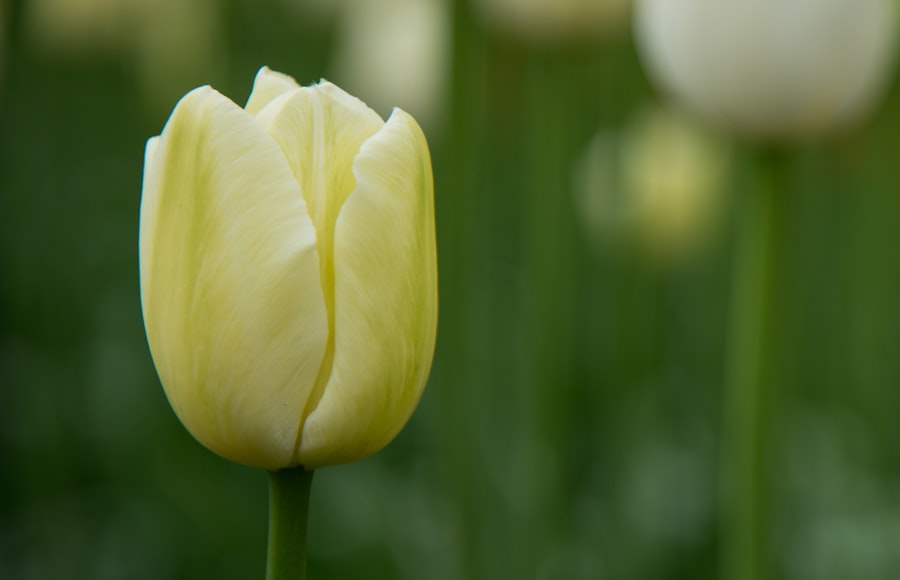From Bulb to Bloom: The Timeline of a Tulip’s Growth – Exploring the Length of Time it Takes for a Tulip to Grow and Flower.

Tulips are one of the most beloved and iconic flowers in the world. Their vibrant colors and elegant shapes make them a favorite among gardeners and flower enthusiasts. But have you ever wondered how a tulip goes from a small bulb to a beautiful blooming flower? The growth process of tulips is truly fascinating, and understanding it is crucial for successful tulip cultivation.
Key Takeaways
- Tulips go through a fascinating journey from bulb to bloom, with several stages of growth and development.
- Planting tulip bulbs is the first step in the growth process, and it’s important to choose the right location and soil conditions.
- During the germination stage, tulip shoots start to emerge and require proper watering and sunlight.
- Leaf development is crucial for tulip growth, as photosynthesis helps the plant store energy for future growth.
- Bulb maturation is when tulip bulbs store nutrients for future growth, and flower bud formation is the exciting stage before tulips bloom.
Planting Tulip Bulbs: The First Step in the Growth Process
The journey of a tulip begins with planting the bulbs. Choosing the right bulbs is essential for healthy growth and beautiful blooms. Look for bulbs that are firm and free from any signs of disease or damage. It’s also important to consider the variety of tulip you want to grow, as different varieties have different requirements.
Preparing the soil is another crucial step in planting tulip bulbs. Tulips prefer well-draining soil that is rich in organic matter. Before planting, loosen the soil and remove any weeds or debris. Adding compost or well-rotted manure can help improve the soil’s fertility and drainage.
When it comes to planting depth and spacing, it’s important to follow the specific instructions for the variety of tulip you are planting. In general, tulip bulbs should be planted at a depth that is two to three times their height. Space the bulbs about 4-6 inches apart to allow for proper root development.
The Germination Stage: When Tulip Shoots Start to Emerge
After planting the bulbs, the germination stage begins. Germination is the process by which the tulip shoots start to emerge from the bulb and grow towards the surface. Several factors can affect germination, including temperature, moisture, and soil conditions.
Tulips require a period of cold dormancy in order to break their dormancy and start growing. This is why they are often planted in the fall, as the cold winter temperatures provide the necessary chilling period. Once the soil starts to warm up in the spring, the tulip shoots will begin to emerge.
Signs of successful germination include the appearance of green shoots above the soil surface. These shoots will continue to grow and develop into leaves and eventually flower buds. During this stage, it’s important to provide proper care to ensure healthy growth. This includes regular watering, avoiding overwatering or underwatering, and protecting the emerging shoots from pests or diseases.
Leaf Development: The Importance of Photosynthesis in Tulip Growth
| Leaf Development Metrics | Importance of Photosynthesis in Tulip Growth |
|---|---|
| Leaf Area Index (LAI) | Photosynthesis is directly related to LAI, which is a measure of the total leaf area per unit of ground area. A higher LAI means more photosynthetic surface area, which leads to increased growth and yield. |
| Chlorophyll Content | Chlorophyll is the pigment responsible for capturing light energy during photosynthesis. A higher chlorophyll content means more efficient photosynthesis and better growth. |
| Carbon Fixation Rate | Carbon fixation is the process by which carbon dioxide is converted into organic compounds during photosynthesis. A higher carbon fixation rate means more efficient use of carbon and better growth. |
| Stomatal Conductance | Stomata are the pores on the surface of leaves that allow for gas exchange during photosynthesis. A higher stomatal conductance means more efficient gas exchange and better growth. |
Leaf development is a crucial stage in the growth process of tulips. Leaves play a vital role in capturing sunlight and converting it into energy through the process of photosynthesis. This energy is then used by the plant for growth and development.
During this stage, it’s important to provide the tulips with the necessary nutrients for healthy leaf development. Fertilizing with a balanced fertilizer can help provide the essential nutrients that tulips need, such as nitrogen, phosphorus, and potassium. It’s also important to ensure that the soil is well-draining and not waterlogged, as excessive moisture can lead to root rot and other diseases.
Bulb Maturation: How Tulip Bulbs Store Nutrients for Future Growth
Bulb maturation is a crucial stage in the growth process of tulips. During this stage, the bulbs store nutrients that will be used for future growth and flowering. It’s important to allow the bulbs enough time to mature before digging them up or cutting off the foliage.
The bulbs store nutrients in specialized tissues called scales. These scales are made up of layers of fleshy tissue that contain stored carbohydrates and other essential nutrients. As the bulbs mature, these nutrients are gradually used up by the plant for growth and development.
Signs of mature bulbs include the yellowing and drying of the foliage. Once the foliage has completely died back, it’s safe to dig up the bulbs for storage or replanting. It’s important to handle the bulbs with care during this stage to avoid damaging them.
Flower Bud Formation: The Exciting Stage Before Tulips Bloom

Flower bud formation is an exciting stage in the growth process of tulips. This is when the flower buds start to develop and take shape, getting ready to burst into beautiful blooms. Several factors can affect bud formation, including temperature, light, and nutrient availability.
During this stage, it’s important to provide the tulips with proper care to ensure healthy bud development. This includes regular watering, avoiding overwatering or underwatering, and providing adequate sunlight. Fertilizing with a phosphorus-rich fertilizer can also help promote bud formation.
The Blooming Stage: The Beauty and Fragrance of Tulip Flowers
The blooming stage is the most anticipated and rewarding part of the growth process of tulips. This is when the flowers open up and reveal their vibrant colors and delicate petals. There are many different types of tulip flowers, ranging from single-flowered varieties to double-flowered varieties.
Several factors can affect blooming, including temperature, light, and moisture levels. Tulips prefer cool temperatures and bright sunlight for optimal blooming. It’s important to provide them with regular watering and avoid letting the soil dry out completely.
During this stage, it’s also important to protect the flowers from pests or diseases that can damage or destroy them. Regular inspection and treatment with organic pest control methods can help keep your tulips healthy and beautiful.
Pollination and Seed Production: The Reproductive Cycle of Tulips
Pollination and seed production are important stages in the growth process of tulips. Tulips are pollinated by insects, such as bees and butterflies, which transfer pollen from the male parts of the flower to the female parts. This fertilization process leads to the production of seeds.
Once the flowers have been pollinated, they will start to wither and fade. The petals will fall off, leaving behind the seed pod. The seed pod will continue to develop and mature, eventually splitting open to release the seeds.
During this stage, it’s important to provide proper care to ensure successful seed production. This includes regular watering, avoiding overwatering or underwatering, and protecting the flowers from pests or diseases. It’s also important to allow the seed pods enough time to mature before collecting the seeds.
Post-Bloom Care: Maintaining Tulip Health after Flowering
After the tulips have finished blooming, it’s important to provide them with proper post-bloom care to maintain their health and prepare them for the next growing season. This includes deadheading and pruning, nutrient requirements, and preparing for dormancy.
Deadheading is the process of removing the faded flowers from the plant. This helps redirect the plant’s energy towards bulb development rather than seed production. Pruning can also be done at this stage to remove any damaged or diseased foliage.
Tulips require a period of dormancy in order to rest and recharge for the next growing season. After the foliage has completely died back, it’s safe to dig up the bulbs for storage or replanting. It’s important to store the bulbs in a cool, dry place until they are ready to be planted again.
Appreciating the Lengthy and Wondrous Growth Process of Tulips
In conclusion, the growth process of tulips is truly fascinating and wondrous. From planting the bulbs to enjoying the beautiful blooms, every stage requires patience, care, and attention to detail. Understanding each stage of growth is crucial for successful tulip cultivation and can help ensure healthy plants and beautiful flowers.
So the next time you see a tulip in full bloom, take a moment to appreciate the journey it has taken from a small bulb to a stunning flower. The beauty and wonder of tulips are a testament to the power of nature and the incredible process of growth and transformation.



